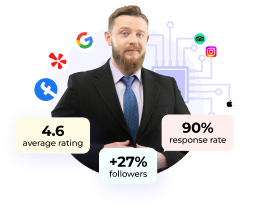Whatever the results and number you have for your clients, you can’t not to speak about them. Reporting, as everybody knows, is hard. The most difficult aspect about it is putting it all into a presentation. At any time you switch on your computer to let your brain make an analysis of work done, you have to be ready to answer the questions: What these numbers mean? Which stats matter to your client? Or why the end results are like that?
Once begun, the chain of questions generating is a never-ending process. And the faster you’ll become a well-aware of how to provide your clients with a detailed information, the more professionally successful you are going to be.
In asking around with awesome agency owners and our amazing PromoRepublic users on the last webinar, Dylan Hey comes to the idea that even if your relationship with different types of tools, tables, and spreadsheets, has, for years now, been closely connected with your work, reporting still takes a lot of your energy up and gets much of your attention.
So, how about saving your time right away and start building a good report, which in the present and the nearest future will help to improve client retention and increase your average client revenue?
— Building a report checklist!
If you have no idea where to start, let’s understand what a social media report is. Simply, it’s a collection of data and stats.
Which data and stats should be outlined there? The obvious answer is that it all depends on the primary goals you and your clients have established.
To clearly understand what is going to be highlighted at the primary place, you need to determine at what thing your clients firstly will pay attention to, for that, break your report down into 2 big parts:
- Page performance
- Paid aids performance
Page performance
- Page likes and Follows
They are important because they reflect brand awareness and show the reaction to content produced. Since this metric calculates the reactions, it turns to be a social proof of popularity and the validity of your strategy.
- Reach and Impressions
Reach is the amount of people who might see the post. This metric shows the exact number of people who are seeing the content you share. Tracking this metric gives an insight on whether the strategy needs some changes or not. While showing it to your clients, you can discuss what is going to be improved and in what way.
- Best posting time
Of course, there is a bulk of theoretical researches about the days of the week, daytime and nighttime which, magically propel your posts on top. However, the results for the business you work with, as it tends to be, may surprisingly differ from a generally accepted rule. Why do you need to include it? This is the time when the post gets the biggest organic engagement and, since it can vary depending on time zone, country, age and sex of your audience, you can show your client suitable parameters.
- Engagement rate
Thanks to this metric, the picture of the success of the brand on social is becoming clearer as it shows how much “people are talking about you”. The difference between the number of likes and engagement is the same as the difference between chalk and cheese. The more people engage with your content, the brighter halo is coming to be around your content, and this, in turn, makes the audience hooked. Like a fuel on which the machine works, comments, shares, and mentions, taken together, build engagement.
- Actions on page
“Big Brother is watching you” is a symbolistic quote written by George Orwell. And this metric reminds this famous fictional character. Even though not every visitor converts, monitoring their behavior lets you know more about the visitors of your page than they know about themselves.
In other words, these metric see what people are looking for, they also know how people act shortly after of seeing what was shown to them, and you and your client can use this information to decide what is going to be to shown to your audience next.
- Reviews
Have only one? That matters. Reviews must be included in the report. The reason why is simple: people always want to be reassured when they’re searching for the products and services online, that’s why they pay attention to what other say. A review is a way to manage the reputation. By the way, while discussing reviews with your client you can come up with the company’s messaging.
What to include in paid aids performance report?
- Campaign type
The simple question here: what did you do?
- Budget
How much did you spend on the campaign? What’s the click cost?
- Format analysis
What format performed better? Image ad, video, carousel, or slideshow?
- Audience statistics
How much traffic your client get from social? What devices do they use when they come to your page? Where they are based geographically?
- Ad place
Even if the budget of your client is endless, explain that the ad can’t be turned in all the marketing channels. Break them down into the categories and add the results they brought.
- Desktop Newsfeed
- Mobile Newsfeed
- Right-hand Column
- Instant Articles
- In-Stream Videos
- Suggested Videos
- Marketplace
Facebook Audience Network
- Native, banner and Interstitial,
- In-Stream Videos
- Rewarded Videos
Messenger
- Home
- Sponsored messages
- Feed
- Instagram Stories
Report presentation
Any regular report reader and maker will immidiatly tell you that complicated reports can’t be understood or remembered. Even more, they are not just boring but extremely boring. What your client seems not to appreciate is that he or she will have to scroll downward through the long-form utterances accompanied by numbers, in large part because of the fear to be cheated.
The golden rule says, “Be honest”. Show what you really have.
Where possible, use graphs, charts, tables, or even word clouds to put a bit more life into the report, per the main context of the end result you want to show.
With visuals and numbers, short descriptions go well. Include them along with examples of social media posts you’re measuring.
Here’s the example of post statistics provided by PromoRepublic.
An effective report will…
- Prove the value and ROI of campaigns you’ve created for your clients
- Highlight your wins and looses
- Analyze the things that can be improved
- Identify the best piece of content
Overwhelming? Don’t be. Passion, time, and good tools will help you to build a detailed report in a context-driven way. If you still have questions spinning round your head, make a cup of your favorite drink and watch a webinar with Dylan who will unexpectedly answer all of them.










